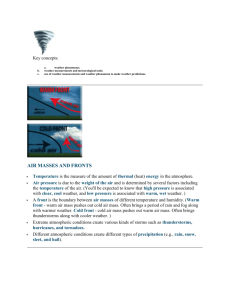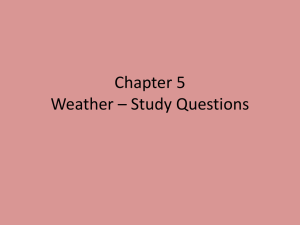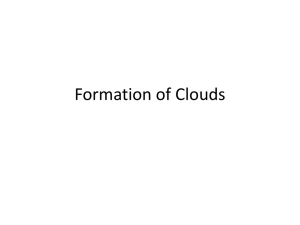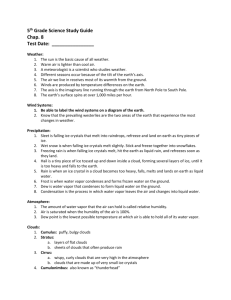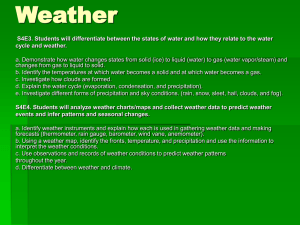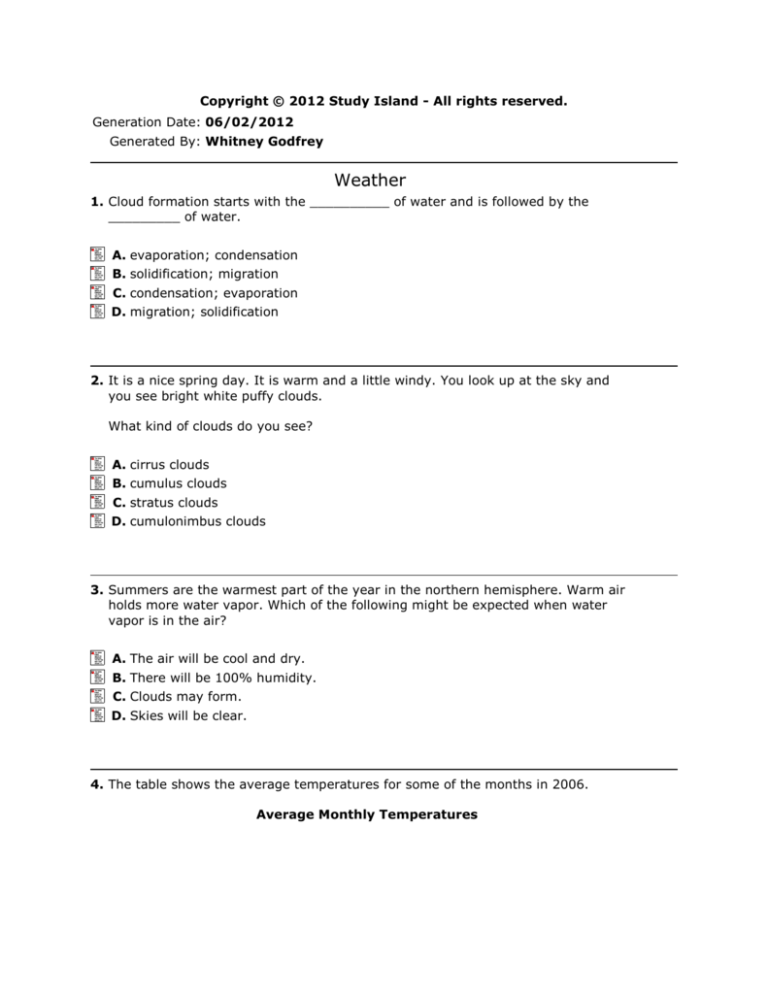
Copyright © 2012 Study Island - All rights reserved.
Generation Date: 06/02/2012
Generated By: Whitney Godfrey
Weather
1. Cloud formation starts with the __________ of water and is followed by the
_________ of water.
A. evaporation; condensation
B. solidification; migration
C. condensation; evaporation
D. migration; solidification
2. It is a nice spring day. It is warm and a little windy. You look up at the sky and
you see bright white puffy clouds.
What kind of clouds do you see?
A. cirrus clouds
B. cumulus clouds
C. stratus clouds
D. cumulonimbus clouds
3. Summers are the warmest part of the year in the northern hemisphere. Warm air
holds more water vapor. Which of the following might be expected when water
vapor is in the air?
A. The air will be cool and dry.
B. There will be 100% humidity.
C. Clouds may form.
D. Skies will be clear.
4. The table shows the average temperatures for some of the months in 2006.
Average Monthly Temperatures
If the weather in 2007 followed the same pattern as 2006, what was most likely
the average temperature in March of 2007?
A. 38°F
B. 56°F
C. 80°F
D. 52°F
5. The summer solstice is the longest day of the year. Which is true about the
temperature at that time?
A. The summer solstice is always the hottest day of the year.
B. The hottest weather is about one month after the summer solstice.
C. The summer solstice is always the coldest day of the year.
D. The hottest weather is about one month before the summer solstice.
6. Fronts are boundaries between air masses of different temperatures and
humidity levels (e.g., between warm and cold air masses). Warm air rises as cool
air moves in to take its place, causing a front between the two different air
masses.
Which of the following can be expected at such fronts?
A. dry weather
B. fog
C. clouds and precipitation
D. clear skies
7. A mass of air moves over the ocean and picks up water vapor. What will probably
happen to that water vapor?
A. The water vapor will travel higher into the atmosphere and escape into space.
B. The water vapor will become trapped in a convection current over the ocean.
C. The water vapor will make clouds disappear, creating a clear blue sky.
D. The water vapor will be carried over land and condense into rain drops.
8. In _____, the number of daylight hours is decreasing. The days can be warm,
and the nights are cool.
The leaves of many trees, like the ones below, turn from green to yellow,
orange, or red.
A. autumn
B. winter
C. summer
D. spring
9. You can tell a cloud is a cumulonimbus cloud when it
A. is very flat.
B. looks white.
C. looks thin.
D. drops rain or snow.
10. The table below shows a forecast of weather conditions for the next week. Use
the table to answer the question.
Weather Forecast
On which day will it be less windy than on Friday?
A. Wednesday
B. Thursday
C. Monday
D. Tuesday
11. It is warm outside, and there is a lot of moisture in the air. The air cannot hold
any more moisture at this temperature.
What will happen next?
A. It will sleet.
B. It will rain.
C. It will continue to be a dry day.
D. It will snow.
12. Tall, dense clouds fill the sky during a thunderstorm, bringing hail, lightning, and
heavy rain. Which type of clouds are these?
A. nimbostratus
B. altocumulus
C. cumulonimbus
D. stratocumulus
13. Monica notices white, wispy, thin clouds, high in the atmosphere. Which type of
weather is most likely taking place?
A. light rainy weather
B. thunderstorms
C. foggy, overcast conditions
D. fair, pleasant weather
14. Flowers are blooming on many plants and trees. Some animals are having
babies. It is warm during the day and night. The Sun seems to be setting later
and later every day.
What season is it?
A. winter
B. spring
C. summer
D. autumn
15. What is the weight of the air on the Earth's surface called?
A. wind speed
B. precipitation
C. air pressure
D. meteorology
16. The movement and tilt of the Earth cause our pattern of seasons. Temperature
changes come with each season. Which statement is also true?
A. Changes in air pressure cause the Earth's movement.
B. Temperature changes cause changes in air pressure.
C. Air pressure stays the same in a given area.
D. Temperature has no affect on air pressure.
17. It is summer in a certain city. The weather is hot and humid. Which of the
following might be expected?
A. thunderstorms
B. snow
C. light winds
D. dry conditions
18. A national weather map is shown in the picture below.
What does the
symbol on the map stand for?
A. low pressure center
B. warm front
C. high pressure center
D. cold front
19. An increase in greenhouse gases in the atmosphere can cause climate changes
for our whole planet. Which type of changes could be expected over a period of
time?
A. Temperatures will decrease in all climate zones.
B. Temperatures will increase in some areas and decrease in others.
C. Temperatures will stay the same; however, there will be more rain.
D. Temperatures will increase in all climate zones.
20. Tornadoes are one of the most destructive types of severe weather. A tornado
can rip large trees straight from the ground and level buildings.
What weather condition creates a tornado?
A. Two lightning bolts strike in the same place.
B. A convection current reaches speeds of 50 mph or more.
C. Winds traveling in two different directions collide and rotate.
D. Rain begins falling in a circular pattern.
21. Clouds are formed when water vapor
A. rises and cools down.
B. falls and cools down.
C. rises and heats up.
D. falls and heats up.
Answers
1. A
2. B
3. C
4. D
5. B
6. C
7. D
8. A
9. D
10. D
11. B
12. C
13. D
14. B
15. C
16. B
17. A
18. B
19. D
20. C
21. A
Explanations
1. Cloud formation starts with the evaporation of water from water bodies. The water is in
the form of water vapor and rises. The next step of cloud formation is condensation,
which means that the water vapor becomes liquid water again, in tiny water droplets
which cluster together to form clouds.
2. Cumulus clouds are the puffy clouds that look like puffs of cotton. Cumulus clouds that
do not get very tall are indicators of fair weather. If they do grow tall, they can turn into
thunderstorms. The bottoms of cumulus clouds are fairly close to the ground.
3. Warm air rises. As it cools, the water vapor in the air turns back into liquid droplets.
Clouds form when water vapor is added to the air, then the vapor cools enough to
return to a liquid. This is known as condensation.
4. Often, there are patterns in the weather. For instance, winters are almost always colder
than summers in the same place.
Another pattern is that average monthly temperatures are usually very much alike from
year to year. So, to find out what the average temperature was in March of 2007, we
should find out what the temperature was in March of 2006. From the chart, we see that
it was 52°F.
5. Usually, the hottest weather is about a month after the summer solstice. During
the long, summer days, the sun has longer to heat the earth. This heat accumulates.
The nights are shorter, and not as much heat leaves. Cooler weather arrives once
shorter days allow more heat to leave the earth than arrives.
6. Fronts are boundaries between air masses of different temperature and humidity (e.g.,
between warm and cold air masses). Fronts cause warm, moist air to rise. As the warm
air rises, it cools down and forms clouds and precipitation as it cools.
7. The water vapor will be carried over land and condense into rain drops
Water that evaporates from the surface of the ocean becomes water vapor. The water
vapor is carried by warm masses of air to other places in the atmosphere. When the
mass of air cools off enough, the water vapor condenses and forms precipitation that
falls back to Earth's surface. This is part of the water cycle.
8. The change of seasons is a natural pattern that can be predicted.
Autumn is always the season of the year between summer and winter. The leaves of
some trees turn colors and fall off during this season.
9. The cumulonimbus clouds can't hold all their water droplets. When droplets join
together, they form bigger drops. These drops can become so heavy that they fall as
rain, snow, or hail. These clouds look tall, puffy, and gray. They may bring thunder and
lightning.
10. On Friday, the wind is blowing at 5 kilometers per hour (kph). The only day that it is
less windy is Tuesday. On Tuesday, the wind is blowing at 3 kph.
11. When the air cannot hold any more moisture at a particular temperature, the drops of
water will join together, and it will rain.
12. Cumulonimbus clouds are large clouds that reach from the lower levels of the
atmosphere to the upper levels. Cumulonimbus clouds produce thunderstorms, hail,
lightning, and heavy rain.
13. Cirrus clouds are white, wispy, thin clouds located high in the troposphere. They are
usually associated with pleasant weather.
Stratus clouds are low clouds that seem to cover the sky with a gray blanket. These
clouds can mean light rain. Cumulonimbus clouds are tall, fluffy heaps of clouds which
indicate thunderstorms and other types of violent weather.
14. Like many things in nature, there is a pattern to the change of seasons. Spring comes
every year between winter and summer.
During spring, it is usually warm during the day and sometimes at night. The number of
daylight hours increases.
Plants and trees bloom after being dormant during winter, and many animals have their
young.
15. The weight of the air on Earth's surface is called air pressure.
Air pressure is determined by many factors, including the temperature of the air. These
changes can be measured with a barometer.
16. Air pressure changes constantly as a result of changes in temperature. Warm air
is less dense than cool air because the molecules are farther apart. So, warm air is
lighter, and has lower pressure. Cool air is heavier and has greater pressure.
17. The air has more water vapor in humid conditions. The warm, hot air rises. The water
vapor condenses as the air cools. Patterns of warm, humid summer weather often mean
evening thunderstorms.
18.
The symbol
shows a high pressure center on the map.
The symbol
shows a low pressure center.
The symbol
shows a cold front.
The symbol
shows a warm front.
Image obtained from http://www.hpc.ncep.noaa.gov/noaa/noaa.gif
19. An increase in greenhouse gases traps heat in our atmosphere. This extra heat affects
the whole world. It can create changes over hundreds of years. Higher temperatures
could be found in all climate zones around the world in the future.
20. Winds traveling in two different directions collide and rotate.
A tornado is a small, rotating column of air that has high wind speeds and low central
pressure and that touches the ground. A tornado is created when winds traveling in
different directions collide and begin to rotate.
21. As water evaporates from seas, lakes, and other water bodies, the water vapor rises. It
cools as it rises. When the water cools enough, it forms droplets of water that group
together to form clouds.
Copyright © 2012 Study Island - All rights reserved.



